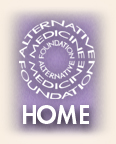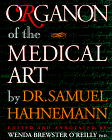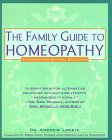HOMEOPATHYAN ALTERNATIVE AND COMPLEMENTARY MEDICINE RESOURCE GUIDE From the Alternative Medicine Foundation, Inc.
The name, homeopathy, comes from the Greek word homio, meaning like, and pathos, meaning suffering. Homeopathic medicines treat illness by going with, rather than against, symptoms that are seen as the body's natural defenses. In contrast, "allopathic" or conventional medicine acts by suppressing the symptoms of illness. The underlying philosophy of homeopathy, known as similia similibus curentur or "like may be cured by like," was developed by Samuel Hahnemann (1755-1843), a German physician, while experimenting with cinchona bark (quinine) as a cure for malaria. When Hahnemann administered cinchona to himself, he developed the symptoms of malaria - fever, diarrhea, vomiting, pain, numb fingers and toes. But when quinine was given to a patient complaining of those same symptoms of malaria, he found it helped them fight the illness. From his initial experiment, Hahnemann and his students methodically tested thousands of substances in a process called "provings". The practice of homeopathic medicine flourished in both Europe and the United States in the late 1800s until the early 1900s. In the early 1900s, there were 22 homeopathic medical schools and over 100 homeopathic hospitals in the United States. The practice of homeopathic medicine dropped sharply with the rise of allopathic medicine, but has regained its popularity in recent years. In Europe, it continues to be practiced along with conventional medicine, particularly in England, France, Germany, and Greece. Homeopathy is extremely popular in India -- which has over 100 four-year homeopathic medical schools - and is also practiced in Brazil, Argentina, Mexico, and South Africa. The underlying principle of homeopathy is "like may be cured by like." That is, a homeopathic substance will produce symptoms in a healthy person that may be used to treat a sick person who has the same symptoms. This principle is used to some degree in conventional therapies, such as immunizations and allergy treatments. The second principle of homeopathy is the minimum dose. In testing the properties of various substances, Hahnemann found that by diluting the substance -- or "potentizing" it -- the remedy worked more effectively. In fact, the more dilute the substance, the greater became its effect or cure, without side effects. Hahnemann theorized that the homeopathic substance, even in infinitesimal amounts, worked by stimulating what he termed the "vital life force," a type of energy that he believed animates all living things. The third principle of homeopathy is its focus on the patient as a whole. In addition to physical symptoms, Hahnemann's provings included an extensive listing of the patient's emotional state. Homeopathic doctors consider the patient's total experience, both mental and physical symptoms and the individual's emotional state, in searching for the appropriate homeopathic substance. A homeopathic practitioner often seeks out what may seem like irrelevant information, such as unusual food cravings, aversion to particular weather conditions, or the time of day that symptoms appear. While the practice of homeopathy has evolved since its founding over 130 years ago, its methodology has essentially remained more or less the same. The homeopathic practitioner takes an extensive case history of the patient, including physical and emotional symptoms. A homeopathic remedy is given for a prescribed amount of time. The doctor notices the change in symptoms, at which time the remedy may be continued or a new one prescribed. There are numerous approaches to homeopathic prescribing, but one of the most widely taught and used is the "constitutional" or "classical" approach. In this approach, after taking the patient's case history, the practitioner selects a single remedy that best fits the patient, considering the range of physical and mental symptoms and the patient's life history. To find the remedy, homeopathic practitioners often consult Kent's Repertory, a comprehensive listing organized by a hierarchy of symptoms, including mental, physical/general, and specific symptoms. The constitutional or classical approach is predominantly used for chronic cases, such as allergies, insomnia, digestion, menstrual difficulties, and behavioral/emotional disorders. Another common approach is known as "acute prescribing" and is used for conditions that have arisen suddenly, such as influenza, cough, diarrhea, or stomachache. These conditions are usually treated with low-potency remedies that may be repeated every few hours. In acute prescribing, remedies are selected based on what is most likely to help that particular condition. An example of a commonly used remedy for acute conditions is arnica, which is given for injuries that result in bruising or muscular pain. "Complex homeopathy" is another common approach to homeopathic prescribing, in which several homeopathic remedies are combined for a given symptom, such as back pain. Combination remedies are usually given for acute symptoms in low potencies. The complex approach has become more popular with the rise of over-the-counter homeopathic remedies, but may also be used by homeopathic practitioners. The appeal of this approach is that it increases the possibility that the right remedy for the patient will be included in the combination, whereas it may be missed in single remedy prescribing. Finally, "instrument-aided prescribing" or "electro-dermal information processing" (EDI) is an approach to homeopathy in which a remedy is chosen based on energetic imbalances in the patient that are measured with a device. In one such device, a pencil-like probe assesses the patient's energy along acupuncture meridian points. The patient holds a metallic tube with a damp cloth around it that is connected via a wire to the machine. If an imbalance is detected in a specific meridian, the homeopath prescribes the remedy by having the patient hold a remedy thought to relieve the imbalance. Homeopathic medicines, commonly referred to as remedies, may come from the plant, mineral, or animal kingdom. Some common remedies include: arnica montana, from the Leopard's bane plant; belladonna, from the deadly nightshade plant; calcarea, calcium carbonate from oyster shells; sepia, from cuttlefish ink; and the element, sulphur. Homeopathic remedies today are produced using the same dilution principles as in Hahnemann's day. In a common dilution of 1:100, one drop of the homeopathic substance is added to 99 drops of water and/or alcohol. The mixture is then potentized by a process called "succussion" - repeated tapping on a hard surface for a specific length of time. Remedies may be diluted up to 1000 times, leaving only an infinitesimal trace of the substance. Remedies are typically diluted 10, 100, or 1,000 times, which translate into potencies that are marked with the Roman numerals X, C, and M. Homeopathic remedies range from 6X as the lowest potency to 1M or more as the highest potency. Remedies can be taken orally in pill, powder, or drop form, rubbed topically, or injected. There are usually no side effects from homeopathic treatments, but a patient can experience what is called a "healing aggravation," a temporary accentuation of symptoms. This is seen as a positive sign that the remedy is working. Depending on the severity of the symptoms, a homeopath may choose an antidote, which produces the opposite effect of the remedy. The antidote may be another homeopathic remedy, or a strong substance, such as perfume, camphor, or coffee, which are known to block the effects of a remedy. In the United States, the Food and Drug Administration (FDA) has recognized homeopathic medicines as drugs since 1938, working with the Homeopathic Pharmacopoeia Convention to produce and update their reference book of homeopathic medicines. Over the years, the FDA has classified homeopathic medicines as either prescription or more commonly as non-prescription (over-the-counter), depending on their strength. In the United Kingdom, homeopathic medicine has been part of the National Health Service (NHS) since it began in 1948. There are currently 5 homeopathic hospitals in the NHS. Homeopathic medicines are available over-the-counter or by prescription. Because homeopathic remedies are so small in dose, often containing no molecular trace of the active ingredient, much of the scientific and conventional medical community maintain that they cannot work. Moreover, in homeopathy, it is claimed that the more a solution is diluted, the more potent it becomes, going against the conventional drug model that the higher a drug dose, the stronger its effect. However, a number of clinical studies and research trials have shown that homeopathic medicines can produce demonstrable physiological and clinical changes. A summary of peer-reviewed journal articles, clinical studies, and meta-analyses are available on the National Center for Homeopathy web site: http://www.homeopathic.org/ Similarly, the British Homeopathic Library is available online at http://www.hom-inform.org/ There are many training programs and courses in homeopathy in the United States and abroad. Naturopathic doctors often receive extensive training in homeopathy, as well as in other techniques such as herbal medicine and vitamin therapy. A minority of medical doctors, especially in the fields of pediatrics and family medicine, has trained in the use of homeopathic treatments to treat chronic conditions that may not respond well to prescription drugs. Chiropractors, nurses, dentists, and veterinarians are among the health care professionals that have chosen to be trained in homeopathy, as well as individuals interested in its unique approach to health. No diploma or certificate from any school or program conveys a license to practice homeopathy in the United States, and there is currently no recognized national standard for homeopathic education. However, a few organizations, such as the American Board of Homeotherapeutics, certify practitioners with a "diplomate of homeopathy" (D.Ht.) award. Practitioners who receive this certification must take continuing education in the field and write journal articles to maintain their standing. The Council on Homeopathic Education has been evaluating homeopathic educational training for the past 14 years. They provide a list of beginner, intermediate, and advanced homeopathic training programs that they have accredited. In the United Kingdom, some medical doctors practice homeopathy, receiving certification through the Faculty of Homeopathy. The Faculty also offers 3-year training programs for those with non-medical backgrounds. The professional organizations listed below publish directories of qualified homeopathic practitioners. In addition, holistic health stores often provide the names of practitioners in their geographic area. For additional resources on relevant Alternative and Complementary Resources, see our Resource Guides on:
NOTE: The following resource listings are not intended to be comprehensive, nor to be used as a guide for treatment. They are provided for information only. The resources are selected and categorized to help you with your own research: AUTHORITATIVE RESEARCH RESOURCES
British Homeopathic Journal
http://www.naturesj.com.bhj/ 2 Powis Place Great Ormond Street London WC1N 3HT England The official peer-reviewed journal of the Faculty of Homeopathy, it is published internationally on a quarterly basis. Journal of Alternative and Complementary Medicine http://www.liebertpub.com/ACM/default1.asp Has many research and clinical homeopaths on the editorial board and publishes frequent articles on homeopathy. Journal of the American Institute of Homeopathy 23200 Edmonds Way #A Edmonds, WA 98026 The Institute publishes a peer-reviewed journal on homeopathy for physicians and other practitioners of homeopathy.
American Institute of Homeopathy Homeopathic Pharmocopoeia Convention of the United States
Promotional and commercial sites are not included in this listing unless they provide significant impartial information resources. Main Sites for Research Information http://www.homeoint.org/english/index.htm Classic texts available online. Hom-Inform http://www.hom-inform.org/ British Homoeopathic Library and Hom-Inform Information Service HPUS http://www.hpus.com/ Web site of the Homœopathic Pharmacopœia of the United States (HPUS) Homeopathy OnLine http://www.lyghtforce.com/HomeopathyOnline/ Online Publication of the international Homeopathy email discussion list. Additional sites abc homeopathy http://www.abchomeopathy.com/ Site includes an introduction to homeopathy, many links to UK, US, and other international homeopathy organizations and sites, and features the "Online Homeopathic Remedy Finder". Canada's One-Stop Homeopathy Network http://www.canadahomeopathy.com/ Features include a newsletter, "Find a Homeopath" in Canada, homeopathy for pets, homeopathy career, and consumer information and resources. Homeopathy Home http://www.homeopathyhome.com/ A commercial site, but with extensive neutral information resources. Homoeopathic Information Service http://www.hominf.org.uk/ Provides information about homeopathy to the general public as well as information services for professional homeopaths, and an online list of practitioners in the UK. Homoeopathic Nurses Association National Center for Homeopathy |
||||||||||||||||||||||||||||||||||||||||||||||||||||||
|
|
||||||||||||||||||||||||||||||||||||||||||||||||||||||
|
Last Updated: May 21, 2010
|
||||||||||||||||||||||||||||||||||||||||||||||||||||||
|
|
||||||||||||||||||||||||||||||||||||||||||||||||||||||
 |
||||||||||||||||||||||||||||||||||||||||||||||||||||||
|
© Copyright © 1998-2010 Alternative Medicine Foundation Inc., Potomac, Maryland.
All rights reserved. |
||||||||||||||||||||||||||||||||||||||||||||||||||||||









